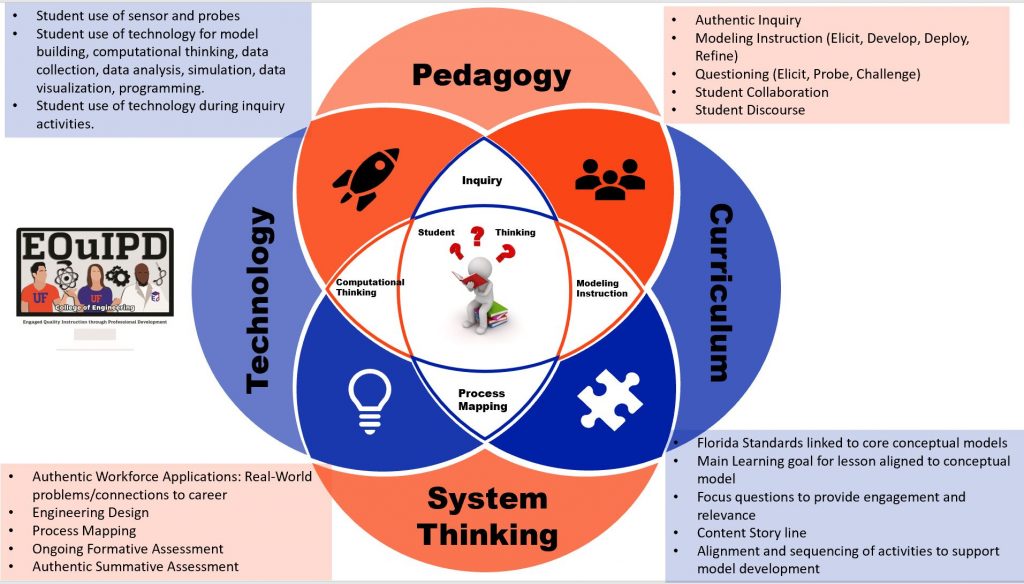Achieving effective student learning lies at the core of our efforts and framework of goals. We emphasize the use of truly powerful tools and strategies including inquiry based lessons, technology, and computational thinking. This results in students who are better prepared to achieve their goals and successfully navigate their careers.

Inquiry Based Lessons
The four-level continuum (confirmation, structured, guided, and open) outlined by Banchi et al (2008) is a useful way to classify the levels of inquiry. This approach is heavily emphasized while coaching our teachers to equip them with the machinery for designing more effective lessons and activities. In turn, the students move toward deeper scientific thinking.
Student Use of Technology
We live in what truly is the golden-age for technology, with various types of advanced technology widely available to us, e.g., sensors and probes (light, sound, heat), modular and visual-based coding tools (Scratch, micro:bit), etc. A common misconception is that the goal of education should be to simply maximize the use of technology. Our coaching, however, also lays equal emphasis on being cognizant of how the use of technology is aligned to the lesson goal. This modified lens allows us to objectively improve the lesson itself, whilst enabling the students to gain hands-on experience with technology.
Collaborative Grouping
Working effectively in groups is an essential skill-set for virtually all work-forces. By encouraging students to work in groups towards a common goal, they benefit from listening to multiple perspectives, and learn how to communicate their ideas to a diverse set of people. In addition, this fosters a better understanding of the specific roles of the various members of a group.
Conceptual Model Building
Education standards are an invaluable resource for educators and students. We coach teachers to understand and provide context to these seemingly disconnected set of standards and build more robust conceptual models, with the models becoming more and more detailed and robust with increasing grade levels. The stages of inquiry (Elicit, Develop, Deploy, and Refine) are explored and used as powerful tools to analyze and design various parts of a lesson.
Engineering Design
The ability to systematically develop novel solutions to various problems is a crucial skill-set in all spheres of an individual’s life. We foster this skill-set by emphasizing the framework outlined by the Hasso-Plattner Institute of Design at Stanford, i.e., the Stanford design thinking model. This 5-step model (Empathize, Define, Ideate, Prototype, Test, Assess) lends itself to a wide variety of problems that one might encounter in their lives.
Systems Thinking
Students and teachers are encouraged to understand the connections and dependencies between the different parts of a model when developing conceptual models. Classroom processes such as process mapping are deliberately emphasized in our training and lead to powerful and effective problem-solving.
Authentic Workforce Applications
It is not uncommon to find a considerable mismatch between the expectations of the workplace and the skills that students develop during their education. By focusing on guidelines well-established by the Common Career Technical Core (CCTC), we equip our teachers, and in turn, students, with the skills they need to function competently in the workplace. Teacher field trips help us bridge the gap between classroom learning and an effective workforce.
Classroom Discourse
Traditional classrooms evoke a picture of a heavily one-sided communication format. We strive towards striking a balance between teacher-student and student-student interactions to deepen understanding and support critical thinking. Students communicating professionally with each other as well as the teacher promotes a free exchange of ideas, providing them with the opportunity to build on each others’ ideas.
Computational Thinking
- Using abstractions and pattern recognition to represent the problem in new and different ways
- Logically organizing and analyzing data
- Breaking the problem down into smaller parts
- Approaching the problem using programmatic thinking techniques such as iteration, symbolic representation, and logical operations
- Reformulating the problem into a series of ordered steps (algorithmic thinking)
- Identifying, analyzing, and implementing possible solutions with the goal of achieving the most efficient and effective combination of steps and resources
- Generalizing this problem-solving process to a wide variety of problems